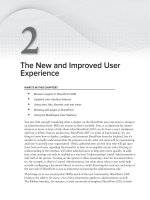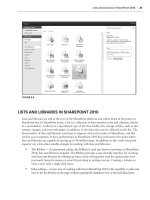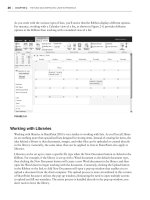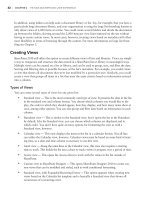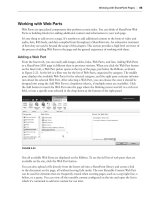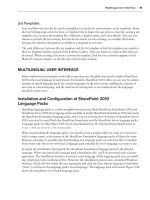Thủ thuật Sharepoint 2010 part 15 pptx
Bạn đang xem bản rút gọn của tài liệu. Xem và tải ngay bản đầy đủ của tài liệu tại đây (599.97 KB, 10 trang )
Installing and Confi guring
SharePoint 2010
WHAT’S IN THIS CHAPTER?
Running prerequisiteinstaller.exe and setup.exe
Avoiding standalone installation
Running the Confi g Wizard
Running the Central Administration Wizard
Handling post-setup confi guration
Installing SharePoint 2010
Please read this chapter! It has become commonplace for IT professionals and consultants to
just “wing” the installation and confi guration of software, fi guring if there are any issues along
the way a quick trip to Bing will get them squared away. While this may be true, it is hardly
considered best practice.
This chapter walks you through all of the steps necessary to get your users a SharePoint site
they can access. Starting with installing the software and then working through running the
two confi guration wizards, you will be on your way. Once you are done with the wizards, you
will make some additional changes to Central Administration. With all of the knobs turned
and the buttons pressed, you will then create a web application and site collection. At that
point you are ready to turn over SharePoint to the users. Then there is nothing to do except
cross your fi ngers and hope for the very best. Or if you are the proactive type you can check
out Chapter 15 where monitoring is covered.
audits—essentially, walking through the install and confi guration steps performed
to build out a server farm and discovering and correcting the errors found with the initial
4
86
CHAPTER 4 iNstalliNg aNd coNfigUriNg sharePoiNt 2010
installation. Can you hazard a guess as to how many of those farms were configured 100% cor-
rectly? The answer is zero. While it is true that some of them only had minor issues, the vast majority
of them had major issues. How were these servers deployed? By the “Next, Next, Bing it” method. It
just doesn’t work.
So read this chapter before attempting to install and configure your server. That way, if it is ever
audited, you can get the highly coveted “Your server is perfect!” feedback.
THE PREREQUISITES INSTALLER
SharePoint installation has followed the lead of a lot of the other Microsoft server software, and now
includes its own tool, the Products Preparation Tool, to install all of those pesky little programs that
are required to make your farm run. Figure 4-1 shows the list of these programs.
FIGURE 41
By default, when you run the tool it first configures IIS for you with the necessary settings. Then it
checks for each of the listed programs and if they are not installed, or if the wrong version is found,
the tool will access the Microsoft Download Center and download and install them for you auto-
matically. Depending on changes made to your server and other updates you may have previously
installed, you may have to reboot at this point. SharePoint will prompt you if this is necessary. Also, if
a reboot is required to continue running the prerequisite installer you will be prompted to click Finish
to perform the reboot. Then when you log back into the server the prereq installer will automatically
pick up where it left off.
For some administrators, the process of having the tool automatically access the Internet to down-
load all of these files is either not possible or not preferable. If you find yourself in this situation, you
The Prerequisites Installer
87
can manually download the files from the Internet. The easiest way to ensure that you are getting
the correct files is to use the link from Figure 4-1 labeled “Learn more about these prerequisites.”
Clicking the link takes you to a TechNet page that contains links to all of the installers. With these
installers in hand you have two options. The first option is to install each program individually to
get everything your server needs; this would be ideal in one-off situations. The other option is to
take advantage of the command-line switches available to the prerequisite installer by running the
following command:
PrerequisiteInstaller.exe /?
Figure 4-2 shows the available installer command-line options.
FIGURE 42
Armed with this information, it is now possible for you to create a command line that installs all of
the prerequisites for you from the locations to which you downloaded them. As you can tell, this is
a pretty long command line and would not be much fun to write, so it’s probably not something you
would want to do for a one-time install. Conversely, if you are trying to streamline the process and
make it repeatable across servers, this might just be the ticket.
88
CHAPTER 4 iNstalliNg aNd coNfigUriNg sharePoiNt 2010
WHERE IS PREREQUISITEINSTALLER.EXE?
Looking for PrerequisiteInstaller.exe? If you have a CD/DVD with SharePoint 2010
on it from Microsoft there is a good chance on the root of that disc you will fi nd the
EXE in question. But, if you are like most people, you just have an Offi ceServer.exe
or SharePoint.exe you downloaded from Microsoft.com. In this case you cannot
access the individual fi les by default. To access the fi les you will need to extract out
the contents of the EXE you downloaded fi rst. To do this, open a command prompt,
navigate to where you downloaded Offi ceServer.exe, and then run the following
command:
OfficeServer.exe /extract:c:\install
This will extract all of the SharePoint fi les and you can then fi nd the preparation
tool at
c:\install\PrerequisiteInstaller.exe.
When the prerequisite installer fi nishes, you should be greeted with an Installation Complete mes-
sage. If any part of the process failed, you will see an error message and a link to the log fi le. It is
a fairly concise, easy to read log fi le, so if you are getting errors don’t be afraid to crack it open. In
most cases it will make it clear what installation or upgrade failed and why.
Two common issues seen with the prerequisite installation to this point are not having connectivity
to the Internet from your SharePoint server and having PowerShell 1.0 already installed. The Internet
issue is pretty obvious, along with the work-arounds noted above for manually downloading them;
but the PowerShell issue requires a bit more explanation. If you are running on Windows Server 2008,
there is a decent chance that you have already activated the Windows PowerShell feature. Some
products will even activate this automatically when they are installed; SQL Server is an example of
an application that installs PowerShell when it is installed. This feature uses Windows PowerShell
1.0 but SharePoint requires Windows PowerShell 2.0. When the prerequisite installer runs, it sees
that Windows PowerShell 2.0 is not installed so it tries to download and install it. However, because
Windows PowerShell 1.0 is already installed, the 2.0 version fails to install, causing the prerequisite
installer to fail. At this point, you need to access Windows Server Manager, deactivate the Windows
PowerShell feature, and then run prerequisiteinstaller.exe again.
RUNNING SETUP.EXE
Now that the prerequisites are out of the way, running setup.exe is the next logical step. Fortunately,
setup does a little checking of its own before it does too much. It will check your system and confi rm
that you have indeed installed all of the prerequisites and that no reboots are needed prior to run-
ning setup. Fortunately you have read the previous section and you have gotten all of the necessary
supporting programs installed.
The need to reboot is a by-product of all the updates that were installed by the prerequisite installer.
Unfortunately, that tool is sometimes too lazy to tell you to reboot, so setup has to step in and deliver
the bad news. Take advantage of the time to go get a drink. If it is the middle of the day the vending
Running Setup.exe
89
machine would be a good place to look for one, but if it is the middle of the night the executive
refrigerator/bar might be calling your name.
If setup should fail for any reason, the best place to look for details is the logs at
c:\program files\
common files\Microsoft shared\web server extensions\14\logs
. Sometimes setup will give
you a handy link, but often you need to find it on your own. Now you know where to look.
Choosing Your Installation Type
After you get through the checks and licensing, you will find yourself facing a crucial decision. Your
choice on the screen shown in Figure 4-3 can make or break you; it is here that you must decide
between a Standalone install or a Server Farm install.
FIGURE 43
The real question is do you want a SharePoint environment you can be proud of and show off to
your dog or do you want something that will make your four-legged friend laugh at you?
Standalone Install
You may have heard standalone installs referred to as basic installs or single-click installs. They have
been around since the early days of SharePoint and are not going away any time soon. They are meant,
with good intentions, for the casual evaluation of SharePoint, the idea being that you click “Standalone
install” and a few minutes later, with no effort on your part, there is a running SharePoint farm for
you to evaluate. The install process will take care of all the details for you. These include installing
a new instance of SQL Server 2008 Express, configuring SharePoint to store all databases on that
instance, configuring all of the necessary service applications, and creating a web application and,
finally, a site collection. You are ready to dive headfirst into evaluating SharePoint. Not so fast … .
90
CHAPTER 4 iNstalliNg aNd coNfigUriNg sharePoiNt 2010
There are a lot of things you should take time to consider before jumping headfirst into this type of
install. The remainder of the section reviews some of the common questions/issues you need to con-
sider before choosing your installation type. Once you read through the rest this section, it should
be clear why Standalone or Basic installs are not recommended. Remember, should you choose to
proceed, you have been warned!
SharePoint, the Proof of Concept That Lasts Forever
It is very common for an organization to quickly stand SharePoint up for “a simple proof of concept
(POC).” The goal of the POC, to try it for one project and see how well it meets the business needs.
Experience has shown that during the POC a lot of permanent, business-critical information ends up
stored within SharePoint. This leaves many unsuspecting administrators stuck supporting a server
that they built as a POC that is now being used as a production server. Had they known this would
happen, they would have never built the POC using temporary methods, knowing it was unsupport-
able. The best advice? Even if the business is calling this an evaluation or POC or some other silly
word and even if they double pinky promise they will have no expectations of this server being per-
manent, do not believe them. Take the time to build the server as if it will be used for production
data. Experience has shown that this is the only way to protect against the POC that becomes the
production environment.
Do You Want SQL Server Express 2008?
That is right, folks. When you choose a standalone install, SQL Server Express 2008 is installed
and configured for you free of charge. SharePoint will then use that SQL Server instance for stor-
ing all of your SharePoint databases. What if you already have SQL Server installed on the server?
It doesn’t matter; SharePoint will still create and use the Express instance, ignoring the previously
installed SQL Server.
The biggest drawback to SQL Server Express is that you cannot have databases larger than 4GB in size.
It’s unlikely that you would buy this big book to support an application with less than 4GB of data.
SQL Server Express is provided for use with both SharePoint Foundation and SharePoint Server,
unlike in the past. Way back in the good old days of Windows SharePoint Services (WSS) 3.0, if
you did a Basic install it was configured to use the Windows Internal Database (WID) engine, which
did not have size limits. Because SharePoint Foundation is not part of Windows, like WSS was, it
cannot use WID. If you are upgrading from WSS 3.0, this change does have some ramifications, as
discussed in Chapter 5.
SQL Express 2008 does not include any GUI based managed tools, such as SQL Server Management
Studio, which is the GUI tool for managing SQL Server. You can use the command-line tool
osql.exe
to manage SQL Express. Or, a much better idea is to download the free tool Microsoft SQL Server
2008 Management Studio Express, available from
.aspx?familyid=08E52AC2-1D62-45F6-9A4A-4B76A8564A2B&displaylang=en
. This will give you
the GUI tools you are used to, and a fighting chance to manage your SQL databases.
It is possible to upgrade the instance of SQL Express to a real version of SQL Server. Check out
for an article on how to upgrade
SQL Server, as that topic is outside the scope of this book. Keep in mind, however, that this won’t
Running Setup.exe
91
negate the other pitfalls of a standalone install, including the fact that SharePoint will always know
you chose standalone, which prevents you from adding additional servers to your installation and
may limit your upgrade options down the road.
What Kind of Permissions Do You Want?
It is very easy to ignore what is happening behind the scenes when you do a standalone install. After
all, isn’t that the point? If you were paying attention to the process you would have noticed you were
never prompted for a username or password. Instead of prompting you for the accounts you want
to configure SharePoint to run with, it will use the Network Service and Local System accounts.
SharePoint uses these accounts to configure the authentication for services, database connections, and
application pools. These two special accounts are used for everything in place of real credentials. For
example, your SharePoint Timer service, which is the lifeblood of SharePoint, is configured to use
Network Service.
While these accounts are great to get you going and to keep you from fretting about creating service
accounts, they are at the mercy of the system. Whenever a new Windows or .NET hotfix comes out,
you have to proceed with extreme caution and confirm that they haven’t reset some permission,
thereby disabling SharePoint from running error free. It has happened with previous versions and it
will most likely happen again. Your SharePoint accounts are so important that Chapter 8 spends a
great many words discussing how and when to use them and what permissions they need. A basic
install just bypasses all of that—not an ideal situation.
Forever Is a Long Time
When you choose a standalone install you are committing to it forever. That’s because SharePoint
always knows you originally did a standalone install. This will constrain a lot of your options going
forward. For example, you will lose the capability to add additional SharePoint servers later when
you want to scale out your system. Chapter 3, which discusses the farm architecture and capacity,
explains how simple it is to add capacity after the fact by just plugging in a new server to the farm.
With a standalone install you cannot add additional servers. If adding another server is an absolute
must, then you must back up your data, format the server and start over from scratch. That doesn’t
seem like much fun.
Your upgrade options may also be limited. Basic installs of 2003 were not able to use all of the 2007
upgrade options. Fortunately, 2007 basic installs aren’t limited in this way when upgrading to 2010,
but who knows what the story will be moving from 2010 to the next version? That is another risk of
this install method.
Patching
Windows Update will only consider installing a SharePoint patch for you if you have done a stand-
alone install. Patching SharePoint servers is a critical task that needs to be undertaken with thought
and planning. The idea that Windows Update might decide to install one at 3:00 a.m. on Tuesday is
a little scary.
The patching mechanisms in SharePoint 2010 have been drastically updated and are actually pretty
cool. Wouldn’t you prefer to be at the helm playing with those new options, rather than be at the
mercy of Windows Update? Check out Chapter 5 for all of the patching excitement.
92
CHAPTER 4 iNstalliNg aNd coNfigUriNg sharePoiNt 2010
Standalone Installation for Developers
There may be one small case where a Standalone install is a decent option. For SharePoint 2010,
both Foundation and Server, Microsoft allows the installation of SharePoint on Windows 7 and
Vista SP1 or SP2. (It does require a 64-bit operating system.) The idea is that developers can install
SharePoint locally, avoiding the need to have a server to do their work. If you choose to go with this
model, then a basic install is the only choice. It is also highly recommended that developers have
access to SharePoint running on Windows Server to test their code, and that the development envi-
ronment matches the configuration of production as closely as possible. For more details and a step-
by-step guide to installing on a Windows client machine, check out
/>en-us/library/ee554869(office.14).aspx
.
The Standalone Installation Process
If this list has not convinced you to avoid a standalone install, or if you need to do one for a specific
reason, such as to create a single-server development environment installation on Windows 7 or
Windows Vista, the process is simple.
When you click Standalone from the splash screen, the install begins immediately. The process
will install all of the bits necessary for SharePoint. Once completed, it will then automatically
run the Configuration Wizard for you. No input is required. If everything goes correctly, the next
time you are prompted is from an Internet Explorer window. Here you choose what template you
would like to use for the root site collection. The install automatically creates a web application at
http://<YourServerName>. At the Choose your template screen, you can also upload a custom
template to the gallery and use that template, which is a nice touch.
Hopefully, you have read this section and will heed its warnings. Standalone installs are very simple
to get up and running, but they lock you into a limited set of options and present a lot of potential
nightmares going forward. If you do find yourself running a standalone install, the best advice is to
back up the databases and format the C: drive.
Server Farm Install
You finished reading the previous section and you get it—don’t do a standalone install—so you
click Server Farm like a good SharePoint administrator and what is your reward? Take a gander at
Figure 4-4 to see.
Eek! The default setting is Stand-alone. How is Stand-alone different from the Standalone install
we just feverishly avoided? Other than their spellings, not a gosh darn thing. That’s right; Microsoft
wants you to do a standalone install so badly they make you avoid it twice. Luckily, you are smart
enough to know better, so select Complete before clicking Install Now.
A complete install will install all of the SharePoint bits on your server but will do nothing to configure
them. Once the install is done, you run the configuration wizards to configure things as necessary.
The key advantage of this approach is that you have complete control of all the service accounts you
use, and what features are activated. In addition, you are free to reconfigure the server at a later time
because all of the functionality is already installed. This flexibility may not seem important on day
one, but as you work with SharePoint and need to scale in new business requirements, you will grow
to appreciate it.
Running Setup.exe
93
FIGURE 44
WEB FRONT END ONLY INSTALL
SharePoint Server 2007 had a third (advanced) install option called Web Front End
(WFE). This option provided you with the fl exibility of adding the server to a farm
and using accounts as you wanted, but it lacked some of the components. The server
only had the capability to act as a web front end, serving up SharePoint pages. You
would sometimes see these servers used in large environments or for public-facing
SharePoint sites. The benefi t was that they had a smaller attack vector because there
were fewer bits on the server to be exploited.
The major drawback was you couldn’t use a WFE-only server as a query or index
server. You lost all deployment fl exibility because you couldn’t move the server roles
around. For example, if you wanted to rearrange your hardware before upgrading
to this version, reallocating WFEs wouldn’t be possible. In order to go from a WFE-
only install to a complete, you have to uninstall and reinstall, something to keep in
mind when choosing between the two.
WFE-only was so infrequently used that Microsoft has removed it from the GUI
installer completely in SharePoint 2010. If you are part of that small minority who
still needs that functionality, it is available through a scripted install.
94
CHAPTER 4 iNstalliNg aNd coNfigUriNg sharePoiNt 2010
Choose a File Location
The File Location tab on the dialog in Figure 4-4 has two fi elds where you can specify locations
for the SharePoint Server fi les and the search index fi les, respectively. From this tab you can change
either from their default C: location without any issue. You can also change the locations later, so
don’t agonize over the settings if you don’t know them now.
Notice there no setting for changing what is known as the SharePoint root or the “14 hive,” the fi les
located at
c:\program files\common files\Microsoft Shared\web server extensions\14.
This is intentional; those fi les should always be left on the C: drive. They generally take up around
1GB of space at maximum.
Scripted Install
For some administrators all of that clicking does nothing but wear out their little fi nger. They fi nd
themselves for one reason or another wanting to automate their install. Because of this, scripted
installs have grown in popularity over the last couple of years. The idea is that working out all
of your confi gurations ahead of time and packaging them into a nice script can greatly accelerate
your recovery plans. This is because, instead of doing an install through the GUI and then reading
through documentation to rebuild your farm, you can just run your initial scripts again and you are
ready to start restoring data.
The fi rst step is modifying a
config.xml fi le with your settings. SharePoint has several fi les with
default settings that you can use as a jumping-off point. If you are doing your install from the down-
loaded EXE fi le, then you have to work a little bit to get to them. First, extract the fi les from the
EXE by running the following command:
Officeserver.exe /extract:C:\install
If you aren’t familiar with how this works refer back to the sidebar “Where Is
PrerequisiteInstaller.exe?” from earlier in this chapter.
After extracting all the fi les to c:\install, look in c:\install\files, where you will see several
folders. Each of those folders contains a different
config.xml fi le. If you open one of the fi les with
your favorite XML editor, such as Notepad, you will see that the fi le is pretty self-explanatory. The
contents of
c:\install\files\setup\config.xml are as follows:
<Configuration>
<Package Id=”sts”>
<Setting Id=”LAUNCHEDFROMSETUPSTS” Value=”Yes”/>
</Package>
<Package Id=”spswfe”>
<Setting Id=”SETUPCALLED” Value=”1”/>
</Package>
<Logging Type=”verbose” Path=”%temp%” Template=”SharePoint Server


